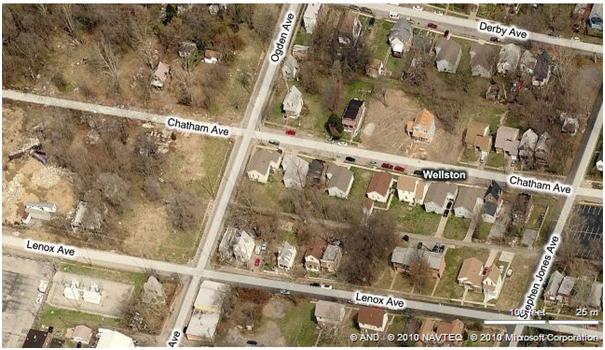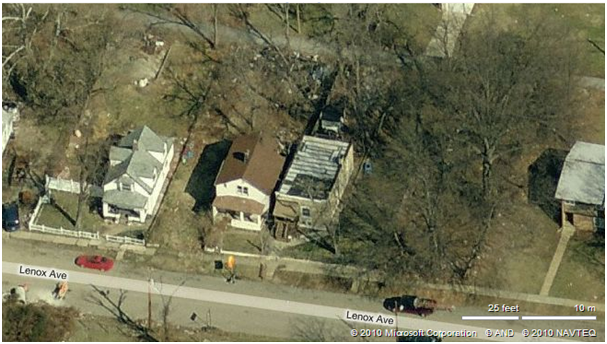I’m intrigued by the phenomenon of the “urban prairie,” what photographer/writer Camilo Jose Vergara calls the “green ghetto.”
“Urban prairie,” says Wikipedia, “is a term coined to characterize large swaths of vacant city lots, typically covered with grass or untended weeds and litter. Urban prairie results from widespread building demolition, common in areas subject to extensive urban decay.” Importantly, the Wikipedia entry notes, “These areas are not the same as a true, natural prairie” – and thus they are not cause for celebration.
Below are two aerial photos of urban prairie taking over the Wellston block where my family once lived. The 6300 block of Lenox Avenue – between Ogden Avenue and Stephen Jones Avenue (formerly Delaware Avenue) – was once the site of numerous houses, but now only a few remain. One lot – seen in the close-up – has been taken over by trees. Could this, in fact, be the former site of our family home?
In The Old Neighborhood: What We Lost in the Great Suburban Migration, 1965-1999, Ray Suarez describes urban prairie in Cleveland:
Today, there are vast stretches of Euclid Avenue with no buildings at all. It’s land that has fallen from the peak of style to dereliction, pausing briefly at all the stops in between. If you have forgotten just how long some of these lots have been vacant, nature provides a clue. Almost three decades after rioting left so many vacant lots, some of the trees in the lots are large, mature, and shady. It’s been a long time since 1968. Only the massive churches sitting like islands in a contextless sea of grass tell you that something big has happened here. By the late 1990s, a few things could not be changed about Hough. It was all black. It was very close to downtown. There were vast pieces of empty land. Off the beaten track, less visible from main streets, the land had returned to an urban bush. The empty lots sported a thick growth of shrub-sized specimens of weeds usually nipped at a few inches by even the most laissez-faire gardener. (163)
While urban prairie is a devastating phenomenon wherever it occurs, urban prairie is a crucial problem in some areas of St. Louis.
As “Exploring St. Louis” blog has documented, urban prairie is a crucial problem in some areas of St. Louis. In an outstanding post, blogger Paul Sableman (“Exploring St. Louis) focuses on the intersection of North Market and 23rd Street – and includes stunning photographs as well as a historical map that can be used as a yesterday-today comparison.
Also useful in thinking about urban prairie in St. Louis is Built St. Louis’s feature on “The Slow Death of a City Block,” which examines the 1900 block of Montgomery Street in North St. Louis. Written by Robert Powers, the site says:
A hundred years ago, fifty, even 30 years ago, the city was full of life, the streets vibrant and bustling, the neighborhoods full of people and activity. But today you can walk around many of the streets in the old city and they’re empty. Nobody’s there. Four decades of urban decay have left the city of St. Louis, Missouri with some of America’s most devastated urban landscapes. . . . What’s happened here is a microcosm of much of St. Louis: the disintegration of urban fabric. Urban design is about creating a series of interconnected outdoor rooms; it is about defined space, spaced scaled for human beings and densely populated with them. Here, the space has lost all cohesion, all definition, all population. The intricate patterns of urbanization are destroyed. The surviving houses sit lost in an amorphous void, their brick party walls standing exposed like raw wounds. . . . The sense of defined, controlled space has vanished. This is now an urban desert – barren open space punctuated by lone survivors. The vacant lots are not an asset. They are not ‘green space.’ They are wasted space. For the city of St. Louis, they are black holes, sucking the life out of the place. Every missing house represents lives gone elsewhere, creativity lost, connections never formed, tax base decreased, vitality diminished. They are a squandered opportunity that the city cannot afford. But the city is full of such places.
Urban prairie is a particular problem in Wellston. As part of his Built St. Louis website, Powers offers an extraordinary photographic tour of this “green ghetto.” All of these shots were taken in the exact neighborhood where my family lived (each within two or three blocks of our family home on Lenox Avenue). Continue onto subsequent pages for more views of present-day Wellston. You can go on a “tour” of urban prairie sites in Wellston by following the tips found in this post. It suggests particular addresses to search for with Google Earth.
But there’s hope – slim though it may be. In Detroit, where urban prairies are particularly striking, urban farming is beginning to emerge. Read this powerful account of the Motor City’s abandoned tracts – and be sure to check out the great photos. Then read this story about GM’s vacant lots becoming urban prairies and the current efforts to reclaim these lots by “greening” them. See also this article about gardening projects in Motown.
Finally, visit the Urban Farming website to learn more about these efforts. The website describes the group’s mission:
Urban Farming’s mission is to create an abundance of food for people in need by planting gardens on unused land and space while increasing diversity, educating youth, adults and seniors and providing an environmentally sustainable system to uplift communities.
Could something like this work in St. Louis?
Finally, to wrap up your exploration of the phenomenon of urban prairie, read preservationist Michael Allen’s provocative insights in “The Empty Space,” a reflection on what’s missing (and what endures) when a building disintegrates or is demolished.
Tags: St. Louis, Urban Prairie, Wellston


I think the area covered by trees is our home site. After Grandma and Grandpa sold their house it was lived in for a while. Then it was torn down and a long building that looked like a duplex was built there. That’s gone too. The lot was empty the last time we drove by.
Mom
Sorry to hear about what happened to the site of your old family home. I hope that someday it will be a place for urban farming, or better yet new homes where families can grow. I know that will be a long time coming though.